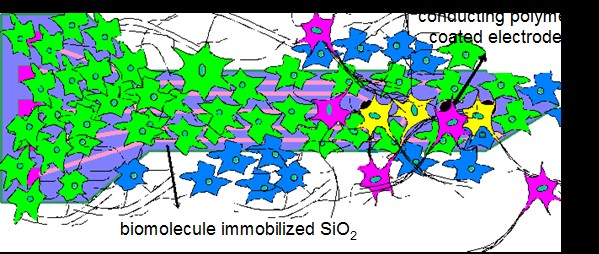Project 1:
Surface coating for neural microelectrode arrays for chronic recording and stimulation in CNS

Neural electrode arrays are implanted in the peripheral and central nervous system for neural recording and stimulation. They are invaluable tools for basic neuroscience studies for understanding brain network or clinical applications such as neural prostheses. Current arrays encounter significant reliability and stability issues over long-term implantation. A major contributor of these issues is the undesired host tissue responses. Several approaches are being explored in our lab to modify the device surface for improved electrode/tissue interface, including biomolecule immobilization to promote neuronal health and adhesion while suppressing glial activation and scar formation, bioactive conductive polymer electrode coatings to improve recording quality or charge injection for stimulation while maintaining a more intimate interaction with the host neurons, and electrically triggered anti-inflammatory drug release directly from the electrode surface.
Some of the publications in this topic area are shown below:
- Xinyan Cui, Valerie Lee, Yehoash Raphael, James Wiler, Jamie Hetke, David J. Anderson, and David C. Martin, Surface Modification of Neural Recording Electrodes with Conducting Polymer / Biomolecule Blends, Journal of Biomedical Materials Research, 2001, Vol 56, n2, 261-27
- Xinyan Cui, James Wiler, Marta Dzaman, Richard A. Altschuler, and David C. Martin, In-vivo Studies of Polypyrrole / Peptide Coated Neural Probes, Biomaterials, Volume 24, Issue 5, February 2003, Pages 777-787
- Xinyan Cui and David Martin, Electrochemical Deposition and Characterization of Poly (3, 4-ethylenedioxythiophene) on Neural Microelectrode Arrays, Sensors and Actuators, B. Chemical, Volume 89, Issues 1-2, 1 March 2003, Pages 92-102
- Cui XT, Zhou DD, Poly (3,4-ethylenedioxythiophene) for Chronic Neural Stimulation, IEEE Transactions on Neural Systems & Rehabilitation Engineering, 15(2007) 502-508
- Luo, X., C. L. Weaver, D. D. Zhou, R. Greenberg, and X. T. Cui, Highly stable carbon nanotube doped poly(3,4-ethylenedioxythiophene) for chronic neural stimulation. Biomaterials, 2011.32(24): p. 5551-5557.
- Azemi, E., C. F. Lagenaur, and X. T. Cui, The surface immobilization of the neural adhesion molecule L1 on neural probes and its effect on neuronal density and gliosis at the probe/tissue interface. Biomaterials, 2011. 32(3): p. 681-692.
- Takashi D. Y. Kozai, Xia Li, Lance M. Bodily, Ellen M. Caparosa, Georgios A. Zenonos, Diane L. Carlisle, Robert M. Friedlander, X. Tracy Cui, Effect of Caspase-1 knockout on chronic neural recording quality and longevity: Insight into cellular and molecular mechanisms of the reactive tissue response, Biomaterials, 2014, 35(36) Pages 9620–9634
- Kozai TDY, Catt K, Du Z, Na K, Srivannavit O, Haque RM, Seymour J, Wise KD, Yoon E, Cui XT. Chronic in vivo evaluation of PEDOT/CNT for stable neural recordings. IEEE TBME. 2015; DOI: 10.1109/TBME.2015.2445713
- Eles JR, Vazquez AL, Snyder NR, Lagenaur C, Murphy MC, Kozai TDY, Cui XT. Neuroadhesive L1 coating attenuates acute microglial attachment to neural electrodes as revealed by live two-photon microscopy. Biomaterials. 2017, 113: 279-92.